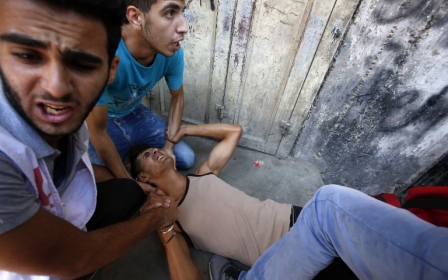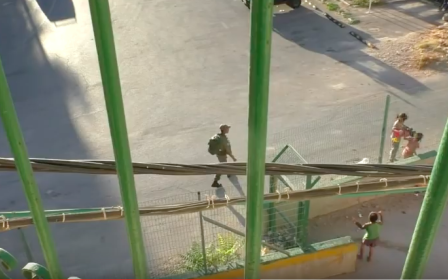Segregated schooling still for Palestinians in Israel

Palestinians in the Israeli-occupied West Bank and the surrounded, blockaded Gaza region have limited opportunities. Like Muslim and Christian communities throughout the Middle East, their demographic make-up is increasingly weighted towards the young. And youth need educational qualifications if they’re going to navigate adulthood successfully, just like, say, Londoners.
As one who has helped researchers at Al-Quds University, I’ve been interested about their prospects.
Al Qud's president Sari Nusseibeh wrote an extraordinary autobiography (Once Upon a Country: A Palestinian Life - Halban Books, 2007), in which he tried to use his cosmopolitan awareness to bypass Israeli officialdom in forming a viable Palestinian state. And keeping AQU open has been almost as difficult.
Gabi Baramki co-founded Birzeit University, the first Palestinian higher education facility, and his own account (Peaceful Resistance : Building a Palestinian University under Occupation - Pluto Press, 2010) was a marvel of education-as-resistance, especially in the years between 1967 and the 1993 Oslo Accords, when soldiers frequently forced closure of the campus.
Then journalist Nick King wrote a not entirely encouraging account of Birzeit, seen as suffering from staff cynicism and occupation fatigue (Education under Occupation - Discovery Analytical Resourcing, 2005).
But I had not turned my attention to Arab-Israeli education until encountering the contemporary study reviewed here. This is a survey of surveys, a mix of many previous studies showing how the Palestinians in Israel are achieving less in higher education section and then, resultingly, in the job market afterwards.
Their take-up in Israeli government-related employment spheres is about 3 percent or less, whether in scientific industries, the legal system, or less dynamic municipal or national departments. Although much of this is common sense, the authors take great pains to support it by referring to previous academic efforts.
Indeed, they are seemingly afraid to say anything without over-signposting each statement with a citation. Make no mistake: this format is correct for the introduction, the foundation of such research, where the text can then move on to set out new revelations. But although there are numerous fascinating facts here, the disinterested, clinical cautions tend to cloud most pages.
In this data-spiced society of studies, Palestinian students are called PAMI, the Palestinian Arab Minority in Israel, and those students have limited choices. While they form 20 percent of the national citizenry, only 13 percent make it to higher education. And it turns out that their options are more limited and passive as they have to take what they can get. This often means studying overseas.
For a start, their school curriculum is almost entirely conceived by the government, so the Zionists’ narratives frame what gets taught. And a theme throughout their schooling is the state’s “vision of the inevitability of tension between Israeli ideologies and PAMI cultural and political perspectives".
Given the identity dualities and discriminations that they face, students might have dubious feelings when applying to an Israeli university, especially when about 40 percent of them get rejected anyway, a higher rejection rate than for Jewish Israelis. Also, they’re not really cohorts with the Jewish Israeli students, who, because of army conscription, have typically waited until age 21 to attend university.
As a result, many seek admission to institutions in other countries, typically Jordan (mainly, for either pharmacology or Islamic studies, plus the cultural affinity) but also Germany, Italy, Romania, and the West Bank, too. Western destinations are mainly for postgraduate work. The authors, however, regard this as temporary or circular migration and no mention is made of students who fancy settling elsewhere. The lure includes a wider range of study fields and financial supports than are available to PAMI in Israel.
In the sense that Israel often gets described nowadays as an ‘apartheid state’, the key to viewing the social landscape there is through the lens of segregation. For generations, American society suffered from both legally and socially segregating white people from African-Americans, which eventually led to a legalised corrective known as ‘affirmative action'. The glass ceilings for the black community in US employment and residence opportunities are still observable, but they have shifted higher as a result. It appears that a similar effort simply hasn’t been made using legislation in Israel.
As you would expect, the separate PAMI schools get proportionally less financial resources per student than the educational institutions for Jewish youths. Psychometric, so-called IQ scholastic aptitude testing, produces fewer non-Jewish blossoms because only the latter get hot-housed.
There are indeed some surprising spices in this stew of statistics. About 29 percent of Israeli Palestinians live below the government-assessed poverty line, but the figure for Jewish Israelis is 12 percent. This makes one wonder where all the $3b annual gift from Washington ends up.
Some points made proved confusing to me. It’s stated that the Palestinian villages still existing in Israel didn’t “move through a natural, transitional phase of development,” but all over the world, where oil, minerals and manufacturing meet, the farm work is the first to get shovelled out of town. For all the convenient romanticism of olive-harvesting that Palestinian rights activists summon, most of the world’s workers would rather toil in an office and have their weekends free. I digress here, but the authors do so continually; despite overall themed chapters, they can’t help themselves from presenting theoretical arguments of any published research that’s crossed their path.
While interpersonal examples can misrepresent a general situation, the lack of them makes this book so distanced from the subject that the reader gets an incomplete understanding of what the life of school and work is like for the PAMI themselves. There’s none of the human interest here that you’d find in some anthropology or old school sociology.
One opening in this curtain is an "Arab" woman, as the authors describe her, lamenting that top students are encouraged into the medical profession, which is deemed ‘safe.’ In the militarised, high-tech Israeli state, "Arabs" aren’t let into those ‘sensitive’ workplaces.
Then again, some of the students’ statements are unreasonable and unchallenged. PAMI pay more than the locals to attend Jordanian universities, but this is true almost everywhere in the world. And some foreign-obtained qualifications aren’t recognised in Israel, but that’s certainly common within the EU itself. But most of the quoted expressions aren’t revealing of anything much, mostly mundane, along the line of university offering enlightenment and new self-identity to the student. It was ever thus.
As racist as the US officially was prior to the 1960s corrective legislation, there were always a few white students at the historically black colleges and universities. The two PAMI authors here work in PAMI teacher training colleges, but are there any non-PAMI students enrolled in them?
To what extent is employment segregated? The reader gets no examples of office politics, even in a civil service setting where PAMI staff are less than one-third their proportional entitlement. There is a reluctance to speak of racial discrimination and even whisper outrage over it.
The career prospects for Israeli Palestinians aren’t exciting, and authors Arar & Haj-Yehia cannot pretend otherwise. But if you’re seeking investigative leads towards a better future for this community, this book is for you.
"Higher Education and the Palestinian Arab Minority in Israel", written by Khalid Arar and Kussai Haj-Yehia and published by Palgrave Macmillan (2016), is available on Amazon.
New MEE newsletter: Jerusalem Dispatch
Sign up to get the latest insights and analysis on Israel-Palestine, alongside Turkey Unpacked and other MEE newsletters
Middle East Eye delivers independent and unrivalled coverage and analysis of the Middle East, North Africa and beyond. To learn more about republishing this content and the associated fees, please fill out this form. More about MEE can be found here.




